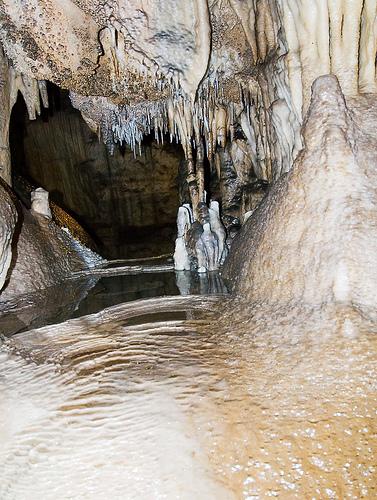Some sort of explosives, believed to date to the 1930s, have been found in Sequoia National Park's Crystal Cave. The discovery prompted the cave's closure and evacuation while the National Park Service's regional chief blaster devises a plan to remove them.
Sequoia officials say the explosives were found along the cave's main passageway Thursday afternoon as employees performed their annual cave restoration and cleaning project. The cave long has been a main attraction at Sequoia. In recent years it has attracted 40,000-60,000 visitors during the summer months, the only time of year tours are led.
The Sequoia Natural History Association received a grant from Sierra Nevada Conservancy, an agency of the State of California, to convert the operation of the cave to solar power instead of using generators. The discovery of the abandoned explosives was made while park Cave Specialist Joel Despain was planning a new lighting system for the cave as part of that conversion.
Park staff originally found wires protruding from three holes drilled into the cave walls immediately adjacent to the trail through the cave. One lies between the Junction and Curtain rooms, another in the Organ Room and the third near Marble Hall. Of the three sites, only one was estimated to have a high likelihood of containing live explosives. This hole is above the tour trail in an unlit area and on the other side of protruding rock. The other two sites appear less likely to contain explosives.
Beginning next week park staff will begin attempts to remotely remove the wires and any attached explosives. It is a distinct possibility that the explosives used to develop the cave included nitroglycerin, which becomes unstable over time.
“We sincerely hope to avoid any explosions in the cave,” said Ranger Despain, “but it is possible that the safest course of action requires detonation, or that disturbance of the wires may cause detonation.”
In preparation for this possibility park staff will install temporary blasting mats and blankets to protect cave formations and features near the three sites.
Park spokeswoman Alexandra Picavet said officials estimated the age of the explosives based on how the wires appeared.
"The wires were coming out and they were cloth-covered, which dates them to pre-1940s," she said this afternoon. "All you can see are wires going into a hole, which is pretty obvious why it's there."
Officials believe the explosives date to the 1930s when Civilian Conservation Corps workers were creating pathways in Crystal Cave.
This weekend the Park Service's regional chief blaster, Dave Karplus, will devise a plan for removing or destroying the explosives.




Comments
Is this guy's title actually Chief Blaster?? If it is, that is a seriously awesome job title :)
That is, I'm told, indeed his official title, and it is definitely a cool one. However, "Master Blaster" would be better, no?;-)
Once again our government has thought up a way to spend a lot of money to solve a very simple problem. Today you can run a fiber optic scope down the hole and see what is in there. Back in the Vietnam era we just blew it up! Still the simple solution for Master Blaster. How many educational degrees does it take to figure that one out? That hole was blasted there in the first place. I'm not aware of the exact location of the drill hole (nice picture - hope it will be preserved - hole I mean). CCC work was very important to get us out of the depression and I still admire their work across America.
EOD Gad has a point. Why think this this thing to death like all other government jobs just take care of it and move on. financially, our parks are stretched to the limits and under funded.